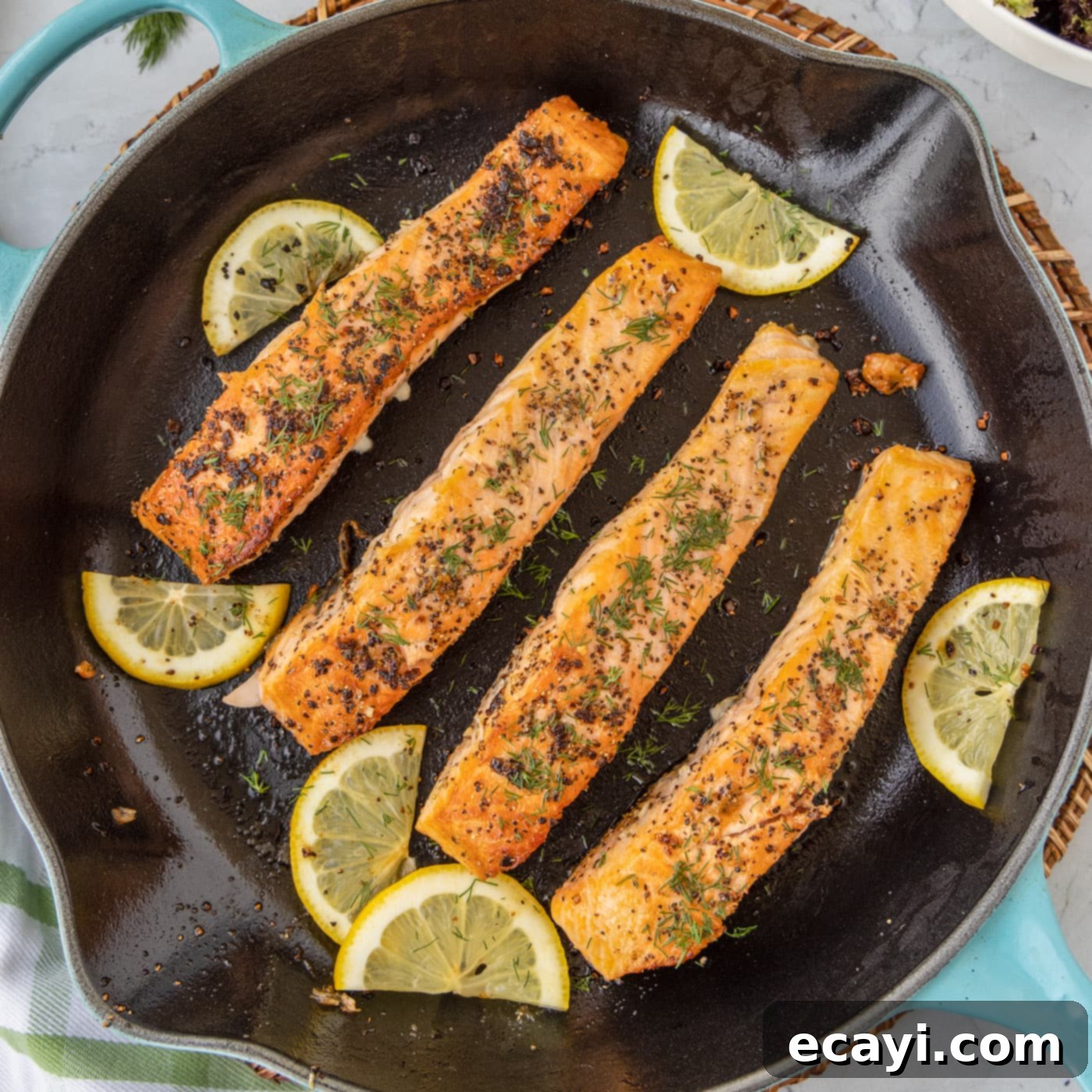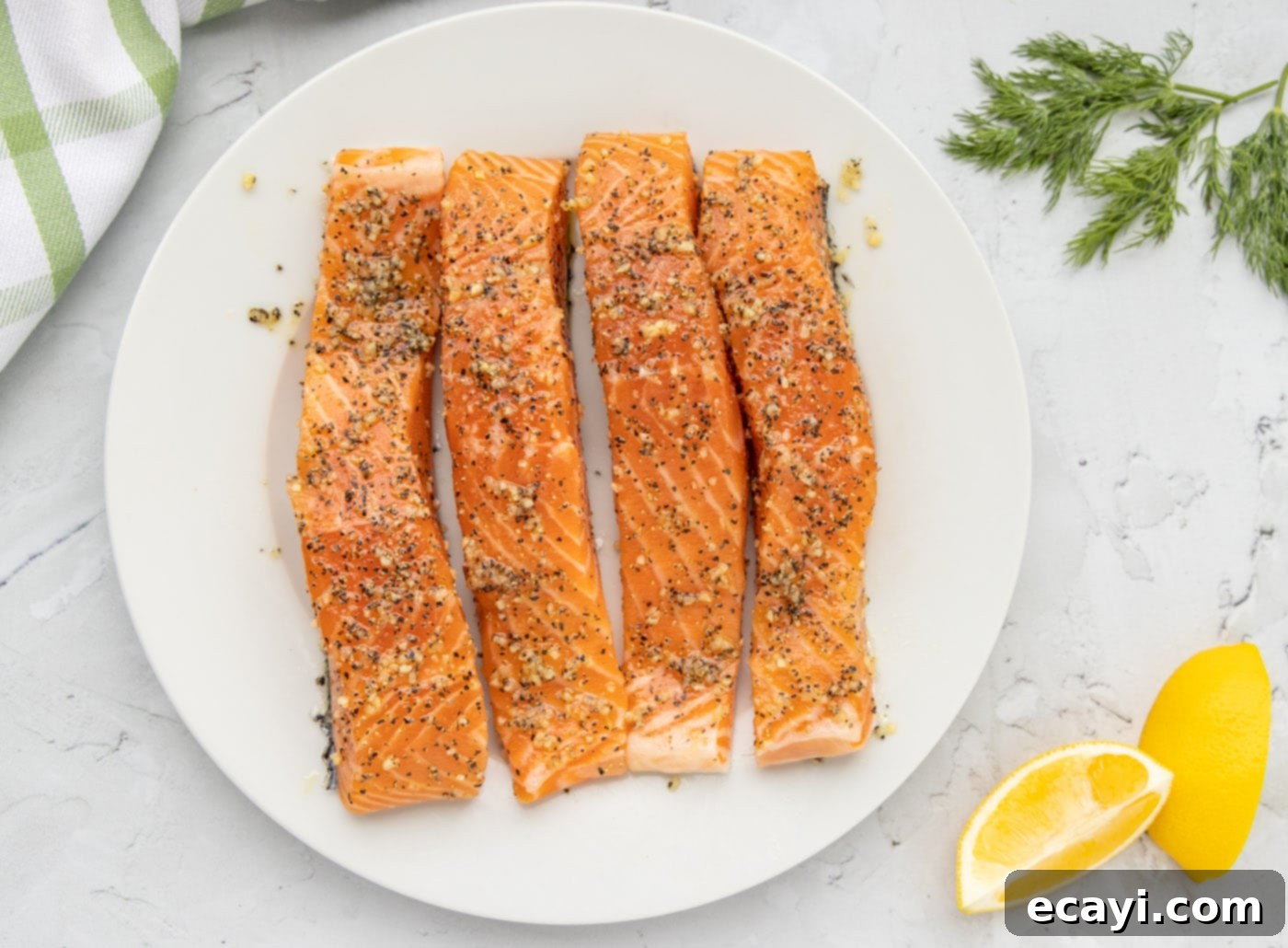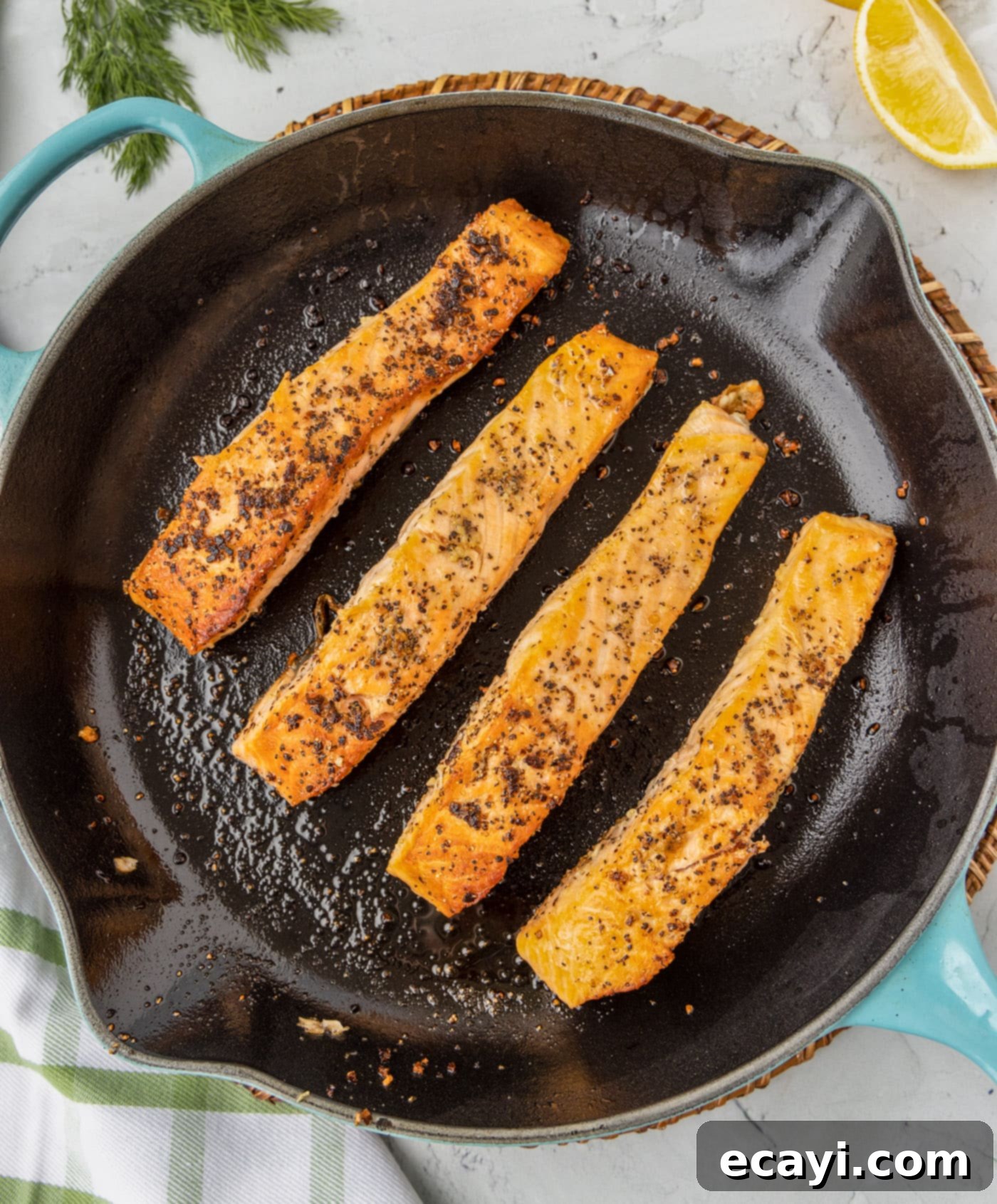Perfect Pan-Seared Salmon: Achieve Crispy Skin and Flaky Perfection in Minutes
Mastering pan-seared salmon means enjoying a delicate golden crust and a succulent, pull-apart flaky inside, all achieved with just about 10 minutes in a hot skillet. This simple yet sophisticated cooking method brings out the best in salmon, making it a go-to for quick weeknight meals or elegant dinner parties. Dive into this guide to create restaurant-quality salmon right in your own kitchen.
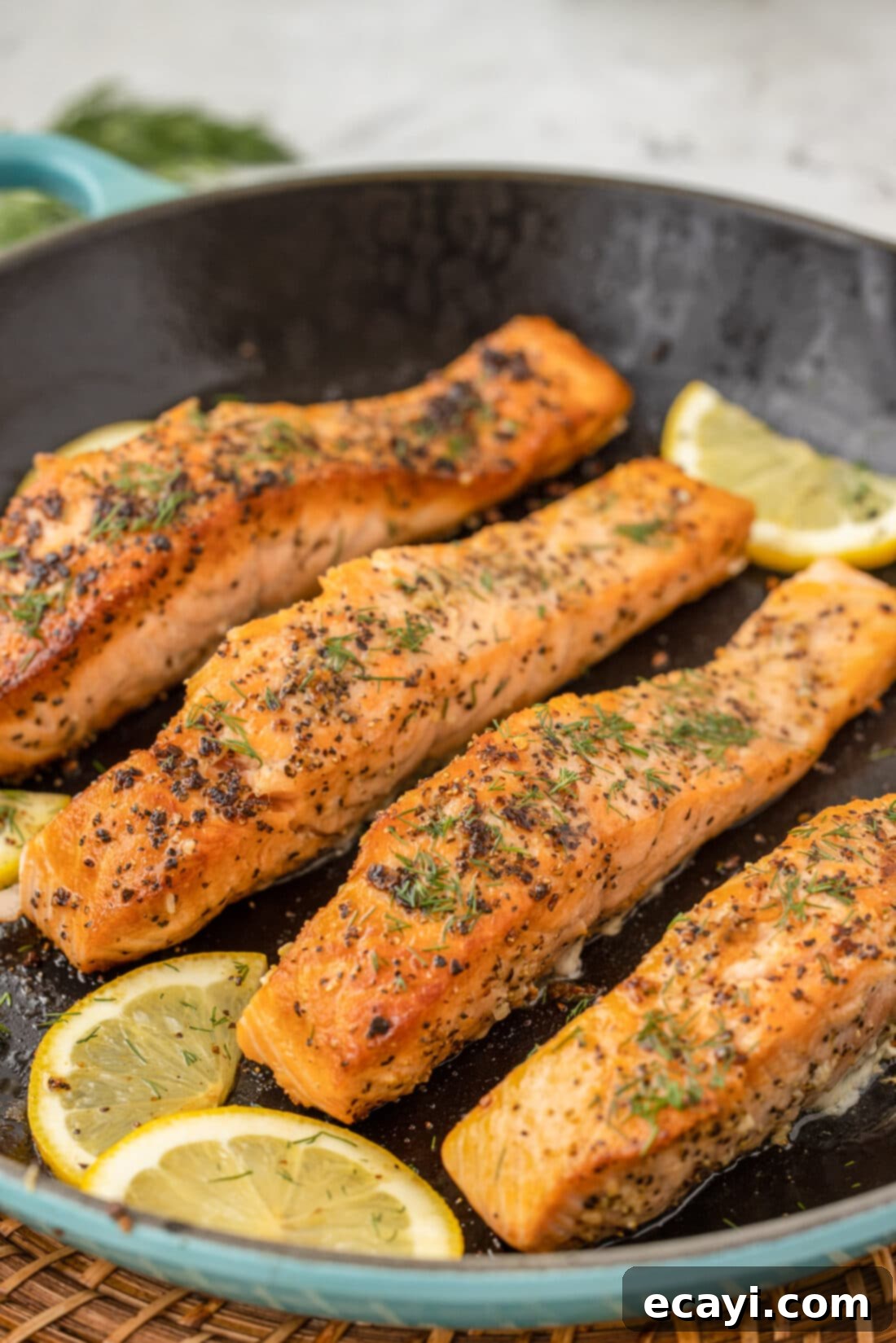
Why This Pan-Seared Salmon Recipe Is a Winner
Often, the most incredible dishes don’t require an extensive list of exotic ingredients. This pan-seared salmon recipe exemplifies that principle, relying on a mere handful of pantry staples: quality olive oil, salt, pepper, and a touch of minced garlic. This minimalist approach ensures that the rich, natural flavor of the salmon itself remains the star of the show, free from unnecessary distractions. While absolutely delicious on its own, a drizzle of a luxurious rosemary cream sauce would elevate it to an even more divine culinary experience.
Our appreciation for salmon runs deep, and we love exploring the many versatile ways this nutritious fish can be prepared. From a quick pan fry to the gentle baking method of baked salmon, the smoky allure of grilling on a cedar plank, or the delicate texture of poached salmon, there are countless avenues to infuse your fillets with incredible flavor. Pan-searing stands out as a favorite for its ability to deliver a perfect crust and tender interior in under 15 minutes, making it ideal for busy weeknights without sacrificing taste or quality.
Beyond its incredible taste and versatility, salmon is a powerhouse of nutrition. It’s packed with omega-3 fatty acids, known for their heart-healthy benefits, brain function support, and anti-inflammatory properties. It’s also an excellent source of high-quality protein, essential vitamins like D and B12, and important minerals such as potassium and selenium. By choosing this pan-seared salmon recipe, you’re not only opting for a delicious meal but also a highly beneficial one for your overall well-being. The simple cooking method preserves these nutrients, ensuring you get the most out of every bite.
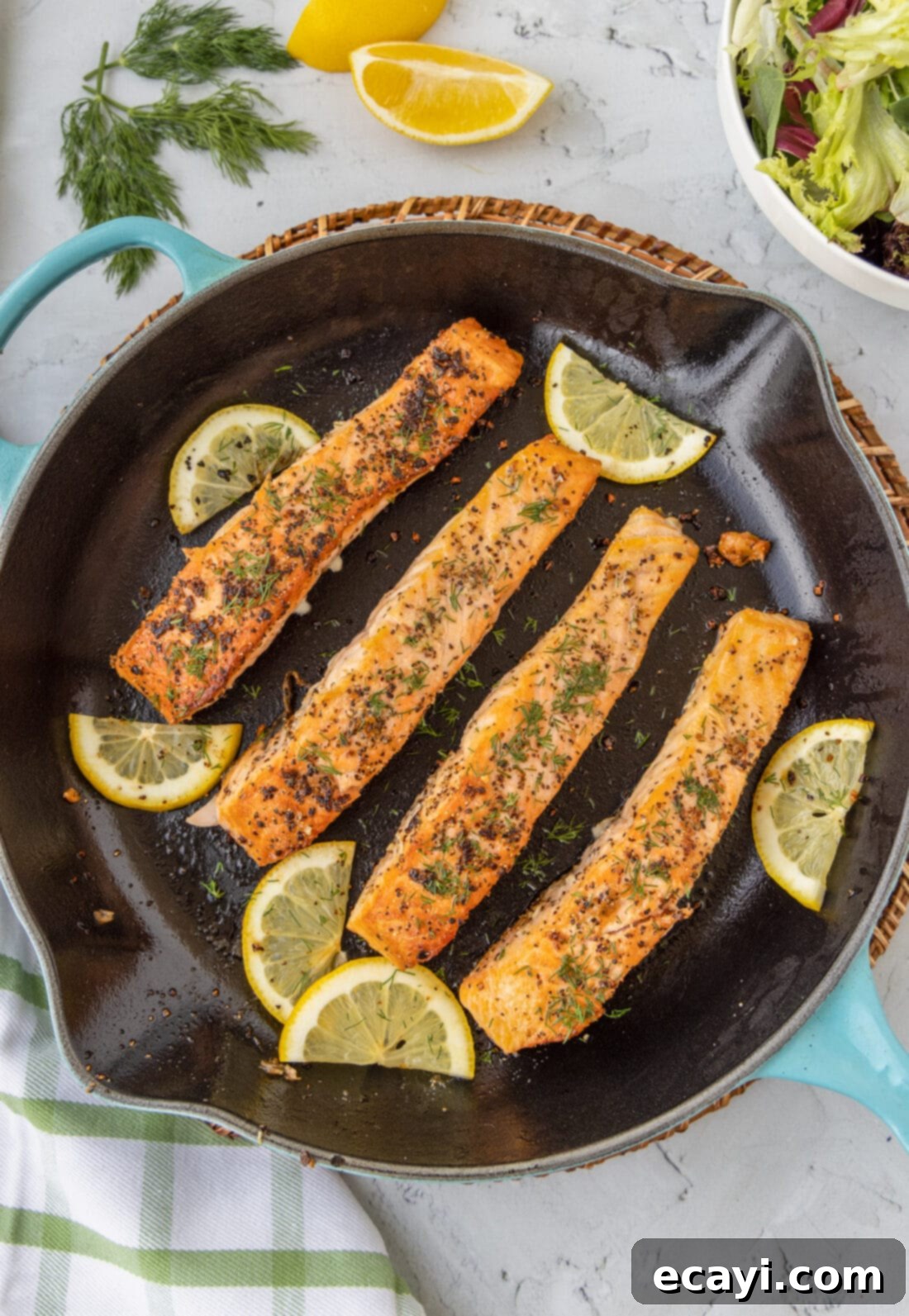
Essential Ingredients for Pan-Seared Salmon
This recipe prides itself on its simplicity, using just a few high-quality ingredients to create a truly memorable dish. You’ll find a complete list of all measurements, ingredients, and detailed instructions in the printable recipe card located at the end of this post.
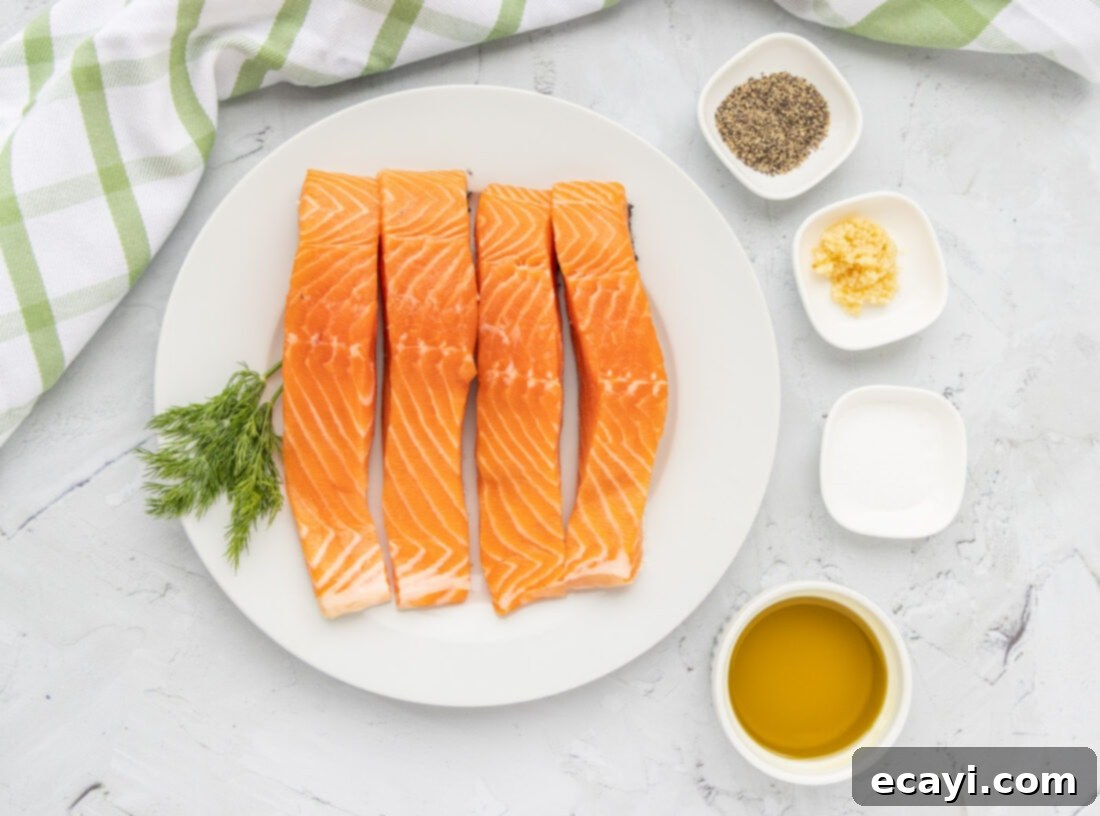
Ingredient Spotlight & Expert Substitution Tips
Understanding your ingredients is key to successful cooking. Here’s a closer look at what you’ll need and how to make smart substitutions:
SALMON – For this recipe, we recommend using 1 1/2 pounds of center-cut salmon, ideally portioned into 4 individual fillets, each weighing approximately 6 ounces. Center-cut fillets tend to be more uniform in thickness, which helps ensure even cooking. If you find it more convenient, pre-portioned 6-ounce fillets commonly available in the seafood section of most grocery stores work perfectly. When selecting salmon, look for firm flesh, a vibrant color, and a fresh, mild aroma. Avoid any fish that smells overly “fishy” or has dull, discolored flesh. For the best results, always bring your salmon fillets to room temperature for about 15-20 minutes before cooking. This crucial step prevents the outside from overcooking while the inside remains underdone, ensuring a perfectly cooked, flaky texture throughout.
OLIVE OIL – A good quality extra virgin olive oil is preferred for its flavor and ability to withstand high heat without smoking immediately. You’ll use it both in the rub and for searing. If olive oil isn’t available, or you prefer a neutral flavor, consider avocado oil or grapeseed oil, both of which have high smoke points suitable for pan-searing.
SEASONING RUB – The basic rub of salt, pepper, and garlic is fantastic for allowing the natural salmon flavor to shine. However, if you’re looking to introduce an aromatic element, incorporating fresh herbs is a wonderful idea. Add 1/2 tablespoon of finely chopped fresh dill or rosemary to the rub mixture for an extra layer of flavor. Other excellent additions include a pinch of smoked paprika for depth, a touch of cayenne pepper for a subtle kick, or a generous grating of lemon zest for brightness. Feel free to experiment with your favorite herb and spice combinations!
How to Craft Perfect Pan-Seared Salmon
These step-by-step photos and detailed instructions are designed to help you visualize each stage of making this incredible recipe. For a convenient printable version, complete with precise measurements and full instructions, simply Jump to Recipe at the bottom of this page.
- Prepare the Seasoning: In a small bowl, combine the salt, freshly ground black pepper, minced garlic, and 1 teaspoon of the olive oil. Mix these ingredients thoroughly to form a fragrant paste. This ensures that all the flavors are evenly distributed.
- Season the Salmon: Gently pat your salmon fillets completely dry with paper towels. This is a critical step for achieving that desirable crispy skin. Then, generously rub the prepared paste all over all sides of the salmon fillets, ensuring an even coating. Don’t forget the sides!

- Heat the Skillet: Place a heavy-bottomed skillet (cast iron or stainless steel works best) over medium-high heat. Add the remaining olive oil to the pan. Heat the oil until it is shimmering and just beginning to show wisps of smoke – this indicates it’s hot enough for a proper sear. A well-heated pan is essential for developing a beautiful crust and preventing the fish from sticking.
- Sear the First Side: Carefully place the salmon fillets into the hot skillet, flesh-side down (or skin-side down if your fillets have skin and you want crispy skin). Cook for 3-4 minutes without moving the fish. This uninterrupted cooking time allows a golden, crispy crust to form. You should hear a sizzling sound immediately upon placing the fish in the pan.
- Flip and Finish: Using a thin, wide spatula, gently turn the fillets over, so they are now skin-side down (if applicable). Continue to cook for another 3-4 minutes, or until the flesh turns an opaque pink throughout and flakes easily with a fork. The cooking time will vary slightly depending on the thickness of your salmon and your desired level of doneness. Use an instant-read thermometer to check for an internal temperature of 145°F (63°C) for perfectly cooked salmon.

- Rest and Serve: Once cooked to perfection, remove the salmon from the skillet and transfer it to a plate. Allow the fillets to rest for 2-3 minutes before serving. This brief resting period allows the juices to redistribute, resulting in a more tender and flavorful piece of fish.
Frequently Asked Questions & Expert Tips for Success
Salmon is safely cooked and ready to enjoy when it reaches an internal temperature of 145°F (63°C). To measure this accurately, insert an instant-read thermometer into the thickest part of the salmon fillet. Visually, the flesh should turn an opaque pink and flake easily when tested with a fork. Avoid overcooking, as this can lead to dry, tough salmon.
Any leftover pan-seared salmon should be stored promptly in an airtight container and kept in the refrigerator. It will remain fresh and delicious for up to 2 days. To reheat, gently warm in a microwave or a low-temperature oven to prevent it from drying out.
Cooking salmon with the skin on is highly recommended, especially for pan-searing. The skin acts as a protective layer, helping the fish retain moisture and preventing it from sticking to the pan. When cooked properly, the skin becomes wonderfully crispy and can be enjoyed for added texture and flavor. If you prefer to remove the skin, do so after cooking; it will be much easier to peel off.
The key to crispy skin lies in a few crucial steps: First, ensure the salmon skin is thoroughly patted dry with paper towels before seasoning. Moisture is the enemy of crispiness! Second, use a hot skillet (medium-high heat) with enough oil. Third, place the salmon skin-side down and don’t move it for the first 3-4 minutes, allowing it to develop a golden-brown crust. Avoid overcrowding the pan, as this lowers the temperature and steams the fish instead of searing it.
A good quality heavy-bottomed skillet is your best friend for pan-searing. Cast iron skillets are excellent for retaining and distributing heat evenly, resulting in a beautiful crust. Stainless steel skillets also work very well. Avoid non-stick pans if you’re aiming for a truly crispy skin, as they often don’t get hot enough to achieve the desired sear.
Yes, you can absolutely use frozen salmon. However, it’s essential to thaw it completely before cooking. The best way to thaw salmon is overnight in the refrigerator. If you’re short on time, you can thaw it in its sealed packaging under cold running water for about 30-60 minutes. Once thawed, pat it very dry to remove any excess moisture before seasoning and searing.
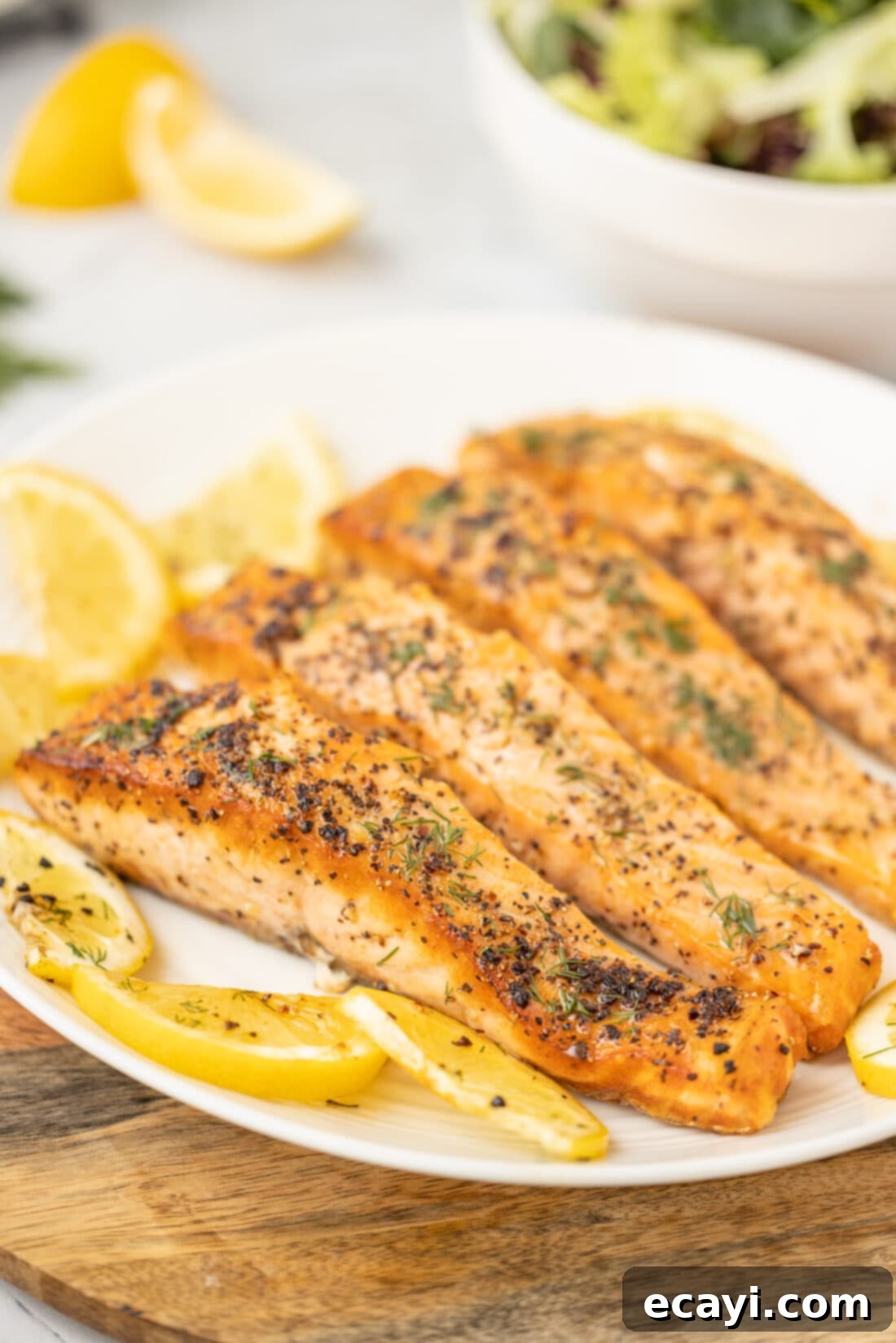
Delicious Serving Suggestions for Pan-Seared Salmon
Pan-seared salmon is incredibly versatile and pairs wonderfully with a wide array of side dishes. For a truly elegant presentation, consider serving it with a luscious rosemary cream sauce drizzled generously over the top. Alternatively, keep it light and fresh by pairing it with a simple squeeze of fresh lemon juice, which brightens the rich flavor of the fish.
Classic vegetable accompaniments include steamed or roasted asparagus, sautéed green beans with garlic, crispy roasted potatoes, or tender glazed carrots. For a more substantial meal, pan-seared salmon is a fantastic complement to fluffy rice pilaf, quinoa, or a light pasta dish. A crisp green salad with a vinaigrette dressing offers a refreshing contrast, while a creamy mashed potato or sweet potato mash adds comforting richness. Don’t forget a sprinkle of fresh chopped parsley or dill for a burst of color and herbaceous aroma right before serving. Enjoy this delightful dish warm, savoring every perfectly cooked bite!
Discover More Irresistible Salmon Recipes
If you love salmon as much as we do, you’re in for a treat! We have a treasure trove of other delicious salmon recipes for you to explore, each offering a unique and flavorful way to enjoy this healthy fish:
- Salmon Tacos: A fresh and zesty twist on taco night.
- Maple Soy Salmon: Sweet, savory, and perfectly glazed.
- Instant Pot Salmon: Quick and easy for busy weeknights.
- Smoked Salmon Dip: A creamy, flavorful appetizer for any gathering.
- Dijon Lemon Caper Salmon: A bright and tangy classic.
- Blackened Salmon: Bold, spicy, and full of flavor.
- Salmon Croquettes: Crispy on the outside, tender on the inside, a nostalgic favorite.
I absolutely adore cooking and baking, and there’s nothing I love more than sharing my culinary adventures and hard-won kitchen wisdom with all of you! We know it can be a challenge to remember to check back daily for new and exciting recipes, which is why we offer a convenient newsletter. Every time a new recipe is posted, it’s delivered straight to your inbox. Simply subscribe here and start receiving your free daily recipes to inspire your next meal!
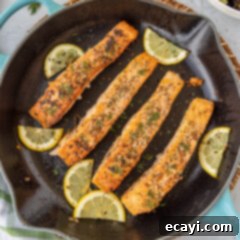
Pan Seared Salmon
IMPORTANT – Don’t miss the detailed Frequently Asked Questions and Expert Tips section within the blog post! Scrolling back up will provide you with valuable insights and common troubleshooting solutions.
Print It
Pin It
Rate It
Save ItSaved!
Ingredients
- 1 ½ pounds center cut salmon cut into 4 fillets, about 6 ounces each
- ¼ cup olive oil divided
- ½ teaspoon salt
- ½ teaspoon black pepper
- ½ Tablespoon minced garlic
Things You’ll Need
-
Large skillet
Before You Begin
- For uniform cooking, ensure your salmon fillets are at room temperature. Take them out of the refrigerator 15-20 minutes before you plan to cook.
- A screaming hot skillet is essential for developing that coveted crispy “crust” on your salmon. Heat your oil until it shimmers but isn’t smoking excessively. If you notice it smoking too much, reduce the heat slightly.
- If you’re looking to enhance the flavor profile, consider incorporating fresh herbs like dill or rosemary. Add 1/2 tablespoon of your chosen finely chopped fresh herbs directly into the rub mixture. Lemon zest is also a fantastic addition for brightness.
- The most accurate way to confirm salmon is done is by checking its internal temperature with an instant-read thermometer. Insert it into the thickest part of the fillet; it should read 145°F (63°C).
- Always pat the salmon skin dry with paper towels before seasoning. This removes excess moisture, which is crucial for achieving crispy skin and preventing the fish from steaming instead of searing.
Instructions
-
In a small bowl, combine the salt, pepper, minced garlic, and 1 teaspoon of the olive oil to create a flavorful paste.
-
Pat the salmon fillets thoroughly dry with paper towels. Then, evenly rub the prepared paste all over the salmon fillets.
-
Heat your chosen skillet over medium-high heat with the remaining olive oil. Wait for the oil to shimmer and be on the verge of smoking before adding the fish.
-
Carefully place the salmon fillets into the hot skillet, flesh-side down (or skin-side down for crispy skin). Cook undisturbed for 3-4 minutes to develop a beautiful crust.
-
Flip the fillets over, so they are now skin-side down. Continue to cook for another 3-4 minutes, or until the flesh becomes opaque pink and flakes easily with a fork (internal temperature should be 145°F / 63°C).
-
Remove the perfectly seared salmon from the skillet and allow it to rest for a couple of minutes before serving to ensure maximum juiciness.
Nutrition
The recipes on this blog are tested with a conventional gas oven and gas stovetop. It’s important to note that some ovens, especially as they age, can cook and bake inconsistently. Using an inexpensive oven thermometer can assure you that your oven is truly heating to the proper temperature. If you use a toaster oven or countertop oven, please keep in mind that they may not distribute heat the same as a conventional full-sized oven and you may need to adjust your cooking/baking times. In the case of recipes made with a pressure cooker, air fryer, slow cooker, or other appliance, a link to the appliances we use is listed within each respective recipe. For baking recipes where measurements are given by weight, please note that results may not be the same if cups are used instead, and we can’t guarantee success with that method.
